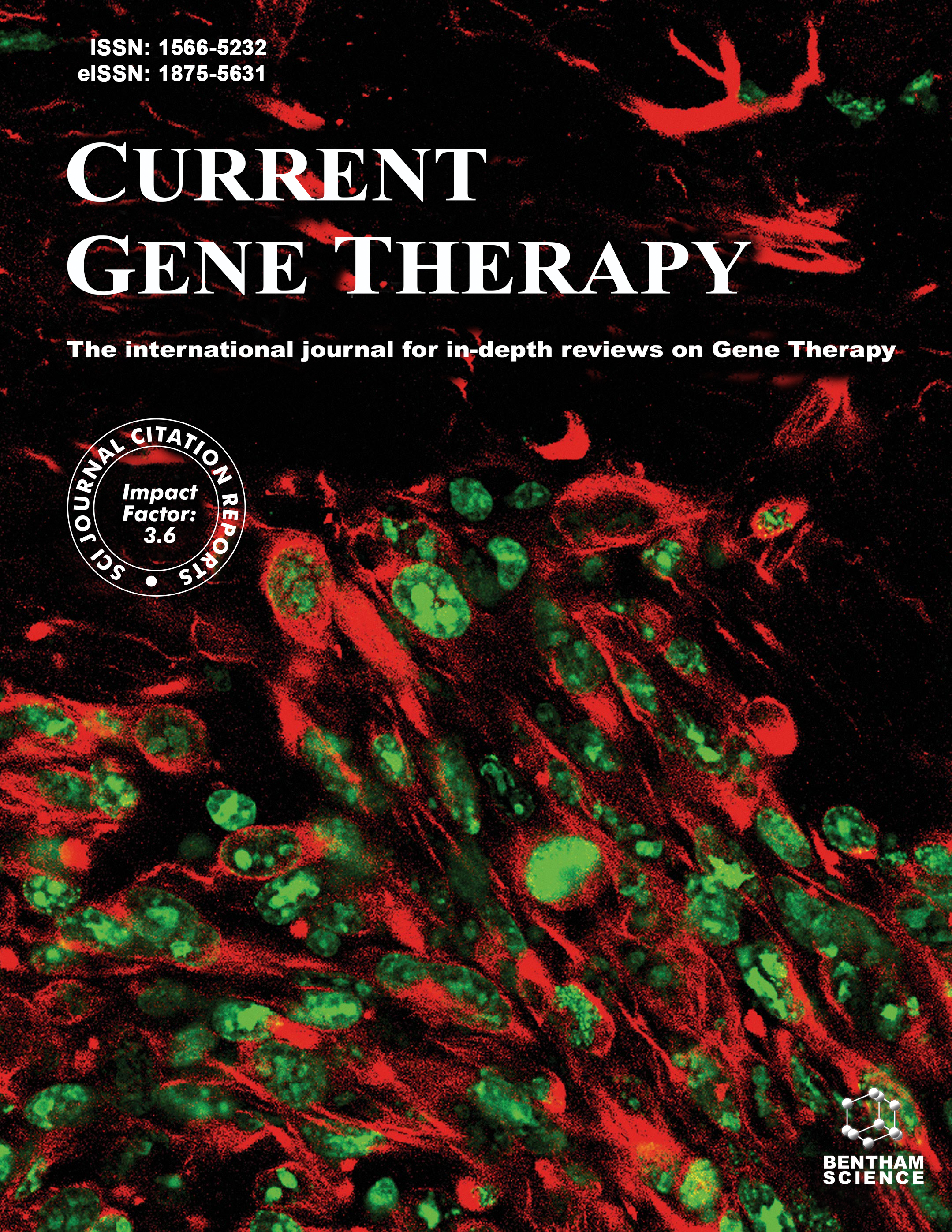- Home
- A-Z Publications
- Current Gene Therapy
- Previous Issues
- Volume 14, Issue 5, 2014
Current Gene Therapy - Volume 14, Issue 5, 2014
Volume 14, Issue 5, 2014
-
-
Single-Stranded γPNAs for In Vivo Site-Specific Genome Editing via Watson-Crick Recognition
More LessTriplex-forming peptide nucleic acids (PNAs) facilitate gene editing by stimulating recombination of donor DNAs within genomic DNA via site-specific formation of altered helical structures that further stimulate DNA repair. However, PNAs designed for triplex formation are sequence restricted to homopurine sites. Herein we describe a novel strategy where next generation single-stranded gamma PNAs (γPNAs) containing miniPEG Read More
-
-
-
Tau Silencing by siRNA in the P301S Mouse Model of Tauopathy
More LessSuppression of tau protein expression has been shown to improve behavioral deficits in mouse models of tauopathies, offering an attractive therapeutic approach. Experimentally this had been achieved by switching off the promoters controlling the transgenic human tau gene (MAPT), which is not possible in human patients. The aim of the present study was therefore to evaluate the effectiveness of small interfering RN Read More
-
-
-
Integrase-Deficient Lentivirus: Opportunities and Challenges for Human Gene Therapy
More LessAuthors: Kuan-Can Liu, Bao-Shun Lin, An-Ding Gao, Hong-Yu Ma, Meng Zhao, Rui Zhang, Hui-Hui Yan, Xun-Fei Yi, Si-Jie Lin, Jian-Wen Que and Xiao-Peng LanLentiviruses are powerful tools for gene delivery and have been widely used for the dissection of gene functions in both replicating and quiescent cells. Recently, lentiviruses have also been used for delivering target sequences in gene therapy. Although the lentiviral system provides sustained exogenous gene expression, serious concerns have been raised due to its unfavorable insertion-mediated mutagenesis effect, thereby r Read More
-
-
-
Codon Swapping of Zinc Finger Nucleases Confers Expression in Primary Cells and In Vivo from a Single Lentiviral Vector
More LessBackground: Zinc finger nucleases (ZFNs) are promising tools for genome editing for biotechnological as well as therapeutic purposes. Delivery remains a major issue impeding targeted genome modification. Lentiviral vectors are highly efficient for delivering transgenes into cell lines, primary cells and into organs, such as the liver. However, the reverse transcription of lentiviral vectors leads to recombination of homol Read More
-
-
-
Reversal of Bone Cancer Pain by HSV-1-Mediated Silencing of CNTF in an Afferent Area of the Spinal Cord Associated with AKT-ERK Signal Inhibition
More LessAuthors: Xu Yang, Jia Liu, Zun-Jing Liu, Qing-Jie Xia, Mu He, Ran Liu, Wei Liu, Wei Wang, Jin Liu, Xin-Fu Zhou, Yun-Hui Zhang and Ting-Hua WangPain induced by bone metastases has a strong impact on the quality of life of patients with cancer, but current therapies for bone cancer pain cannot attain a satisfactory therapeutic goal because of various adverse reactions. Currently, advanced monitoring is required to clarify pathogenic mechanisms, so as to develop more effective treatments. We constructed herpes simplex virus carrying small interference RNA for CNT Read More
-
-
-
Identification of Vβ7.1_H3F7 as a Therapeutic Gene Encoding TCR Specific to Hepatocellular Carcinoma
More LessAuthors: Shulin Huang, Han Shen, Zhiming Li, Sung-Kay Chiu, Runsheng Ruan, Lanfeng Xiao and Chi-Meng TzengThe feasibility of T-Cell receptor (TCR) gene therapy using a MART-1-specific TCR has been previously demonstrated in melanoma patients. However, it remains a challenge without a defined tumor-specific antigen in the therapy of hepatocellular carcinoma (HCC). In this study, through the analysis of clonal expansion of TCR Vβ subfamily and DNA sequencing, we identified TCR Vβ7.1_H3F7 as a potential therapeutic gene Read More
-
-
-
SALL4: Engine of Cell Stemness
More LessThe spalt (sal) family is a class of evolutionarily conserved genes originally identified in Drosophila as homeotic genes required for embryonic development. In vertebrates, the expression of sal-like 4 (SALL4) is specifically enriched in both embryonic and adult stem/stem-like cells. SALL4 is a master regulator that contributes to cell stemness in biological development and tumor growth. Thus, Sall4 has emerged as a target for Read More
-
Volumes & issues
-
Volume 25 (2025)
-
Volume 24 (2024)
-
Volume 23 (2023)
-
Volume 22 (2022)
-
Volume 21 (2021)
-
Volume 20 (2020)
-
Volume 19 (2019)
-
Volume 18 (2018)
-
Volume 17 (2017)
-
Volume 16 (2016)
-
Volume 15 (2015)
-
Volume 14 (2014)
-
Volume 13 (2013)
-
Volume 12 (2012)
-
Volume 11 (2011)
-
Volume 10 (2010)
-
Volume 9 (2009)
-
Volume 8 (2008)
-
Volume 7 (2007)
-
Volume 6 (2006)
-
Volume 5 (2005)
-
Volume 4 (2004)
-
Volume 3 (2003)
-
Volume 2 (2002)
-
Volume 1 (2001)
Most Read This Month
Article
content/journals/cgt
Journal
10
5
false
en

Most Cited Most Cited RSS feed
-
-
New Hope for Intervertebral Disc Degeneration: Bone Marrow Mesenchymal Stem Cells and Exosomes Derived from Bone Marrow Mesenchymal Stem Cell Transplantation
Authors: Xiao-bo Zhang, Xiang-yi Chen, Jin Qi, Hai-yu Zhou, Xiao-bing Zhao, Yi-cun Hu, Rui-hao Zhang, De-chen Yu, Xi-dan Gao, Ke-ping Wang and Lin Ma
-
- More Less

